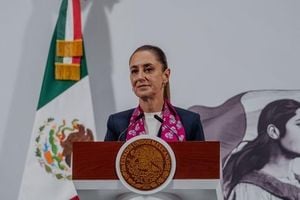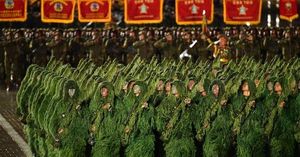China's manufacturing sector continues to face headwinds as official data released on Sunday, August 31, 2025, revealed that factory activity contracted for a fifth consecutive month. Despite a modest improvement in the widely watched purchasing managers index (PMI), which crept up from 49.3 in July to 49.4 in August, the sector remains mired in a downturn, underscoring persistent challenges for the world's second-largest economy. The PMI, measured on a scale from 0 to 100, uses 50 as the dividing line between expansion and contraction. A reading below 50 signals a decline, and while the August figure suggests the pace of contraction has eased, it is nonetheless a sign that recovery remains elusive.
According to the National Bureau of Statistics, indices measuring manufacturing, new orders, and raw material inventory all edged up during August, hinting at some underlying resilience. However, the index tracking employment slipped slightly, reflecting ongoing concerns about job security in the sector. The employment drop, though not dramatic, adds to worries about a labor market already strained by broader economic pressures.
This data arrives in the wake of a significant development in international trade relations. Just weeks before the release of the survey, U.S. President Donald Trump extended a pause on sharp hikes in import duties targeting Chinese goods for another 90 days. The move, which effectively prolongs the trade truce between the two economic giants, was seen by some as a step toward stabilizing relations and providing breathing room for both sides. Yet, uncertainty over future tariffs and the possibility of renewed tensions continue to loom large over export-oriented manufacturers in China.
The extension of the truce was not merely a bureaucratic gesture. During the week of August 23-29, 2025, China's international trade representative Li Chenggang traveled to the United States to meet with American officials and business leaders. According to a statement from China's Ministry of Commerce, the talks focused on implementing the consensuses reached by state leaders and exploring ways to strengthen economic and trade ties. Li emphasized the importance of "mutual respect, peaceful coexistence and win-win cooperation," adding that the two sides should "manage differences and expand cooperation through equal dialogue." His meetings with business representatives further highlighted the desire on both sides to find common ground and avoid escalation.
Despite these diplomatic overtures, the underlying economic reality in China remains fraught with challenges. The manufacturing sector, traditionally a pillar of the country's growth, is grappling with a confluence of negative factors. Chief among these is a downturn in the property sector, which has dampened demand for materials and related manufactured goods. The property market, long a driver of investment and employment, has slowed significantly in recent months, sending ripples through supply chains and consumer sentiment alike.
Adding to these woes is a rise in the national jobless rate. While the official unemployment figure remains closely watched, anecdotal reports from across the country point to mounting difficulties for both blue-collar and white-collar workers. The slight dip in the manufacturing employment index for August, as reported by the National Bureau of Statistics, is just one indicator of a broader malaise affecting the labor market.
Nature, too, has played a disruptive role. Torrential seasonal rains have caused widespread flooding in several regions, upending business operations and compounding the challenges faced by manufacturers. Floods have not only damaged infrastructure and inventory but have also delayed shipments and forced temporary closures in affected areas. For many businesses, especially small and medium-sized enterprises, these setbacks come at a time when margins are already under pressure from weak demand and rising costs.
Despite these headwinds, some officials remain cautiously optimistic. Zhao Qinghe, a senior statistician at the National Bureau of Statistics, pointed to the uptick in the manufacturing, non-manufacturing, and overall PMIs in August as signs that "the country’s overall economic sentiment continued to improve." While the improvement is modest, it suggests that the worst of the contraction may be behind the sector—at least for now.
Still, many analysts and business leaders remain wary. The extension of the U.S.-China trade truce, while welcome, is only a temporary reprieve. The underlying issues—ranging from structural imbalances in the property market to global supply chain disruptions—are unlikely to be resolved in the space of a few months. Moreover, with political rhetoric on both sides occasionally flaring, there is always the risk that negotiations could stall or even reverse course.
For Chinese manufacturers, the immediate future is likely to be defined by a delicate balancing act. On one hand, they must navigate the uncertainties of international trade policy and the ever-present possibility of new tariffs. On the other, they are contending with domestic challenges that threaten to erode competitiveness and profitability. The modest rise in new orders and raw material inventories in August offers some hope that demand may be stabilizing, but it is far too early to declare a turnaround.
Meanwhile, efforts to shore up economic confidence continue at both the national and local levels. Authorities have rolled out targeted support for key industries, encouraged infrastructure investment, and sought to reassure foreign investors that China remains open for business. The recent visit by Li Chenggang to the U.S. is just one example of these efforts, signaling a willingness to engage constructively with international partners even as domestic reforms are pursued.
For now, the story of China's manufacturing sector is one of cautious resilience amid persistent uncertainty. The August PMI data, while not cause for celebration, does suggest that the sector is not in freefall. Instead, it is inching forward—slowly, and with considerable effort—against a backdrop of economic, political, and environmental challenges. As the 90-day trade truce ticks down, all eyes will be on policymakers in Beijing and Washington to see whether this tentative stability can be maintained, or whether new storms lie ahead.
The coming months will be critical in determining the trajectory of China's manufacturing sector and, by extension, the broader global economy. For now, manufacturers, workers, and policymakers alike are holding their breath, hoping that a fragile peace on the trade front and incremental gains in business sentiment will be enough to weather the ongoing storm.




